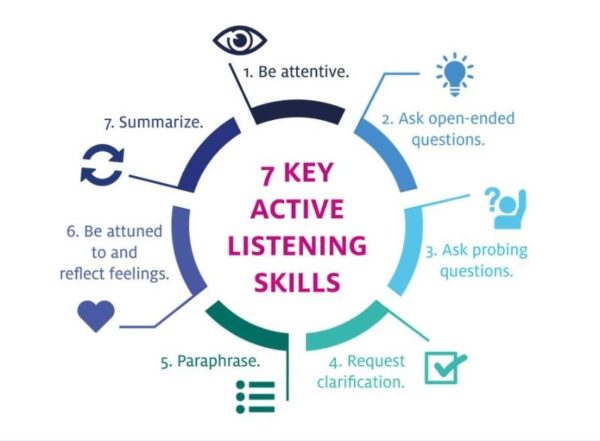7 Strategies to Address Sales Objections & Boost Sales Now

Selling can be... stressful.
First, you feel like you have to walk a fine line between being pushy (I used to think this is how best to sell, but it’s not. More on that later...) and informative.
Then you have to “read the room” and find out what your prospect’s biggest concerns are.
And most important: you’ve got to have an answer to every question buyers have about your products, services, and/or business.
Because if you don’t have all the answers, you’re going to look foolish. And you’re going to end up losing the sale too.
This is especially true when it comes to addressing your lead’s sales objections for high-ticket products and services.
If you don’t know how to overcome objections in sales, your prospects won’t realize that what you’re selling is exactly what they’ve been looking for. The so awaited solution to all of their problems!
It’s no wonder that for many, addressing sales objections can be stressful.
That’s why today I’m showing how to close more sales by effectively handling sales objections.
In this article, you’ll learn:
- 7 data-backed strategies that will help you respond to sales objections more successfully and persuade potential customers to buy from you (without being “salesy”).
- 5 effective responses to the most common high-ticket sales objections.
- Questions you can ask leads to reassure them about your product or service’s benefits and nudge them towards becoming a customer.
All right, let’s go.

Sales Objections: A Necessary Evil Your Sales Team Needs to Conquer
So you’ve come up with the perfect product or service.
It solves a widespread problem.
You’ve validated the market (an essential step especially in launching info products).
And you’ve built it based on copious customer feedback.
But as perfect as your solution is, there are still going to be objections your customers have to buying whatever it is you’re selling.
No matter how refined your product is, people are still going to come up with reasons not to purchase it.
And with high-ticket products and services specifically, people are going to be even more wary of investing large sums in products they’re still unsure about.
That’s why we always follow these sales strategies to close 481%+ more high-ticket sales.
But unfortunately, that’s just the nature of business.
In fact, Bit.ai found that a whopping 96% of your visitors simply aren’t ready to buy when they land on your website.
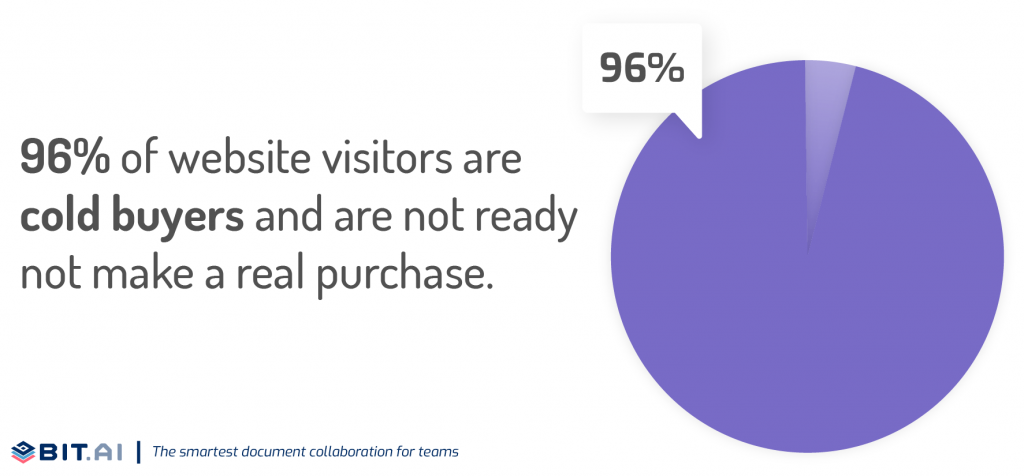
That being said, it’s the job of your sales team to address those buyer objections head on and convince prospects that this is the solution to their problem.
After all, even a perfect pitch for a perfect problem can be ruined by poor handling of a buyer’s objections.
7 Data-Backed Techniques for Handling Objections in Sales
Now, before we get into how to handle specific buyer objections, there are a few general techniques you can use to make addressing objections even more successful.
Rather than specific solutions to objections, then, these are more like small things you can do to make it more likely that...
- Your lead will respond to how you handle their objection positively.
- Your lead will convert into a high-ticket sale.
Let’s check them out.
1. Take a Breath Before Addressing Objections
This technique is just as simple as it is powerful.
When a lead brings up an objection to buying (price, timeframe, features, etc.), instead of answering them right away, take a second to stop and take a breath.
Give yourself time to really think about the answer your lead needs to hear before going on to deliver a response.
Sounds too easy, right?
Well, according to analysis from 67,149 sales call recordings, Gong found that top sales staff actually paused 5X longer than average performers after being confronted with an objection.
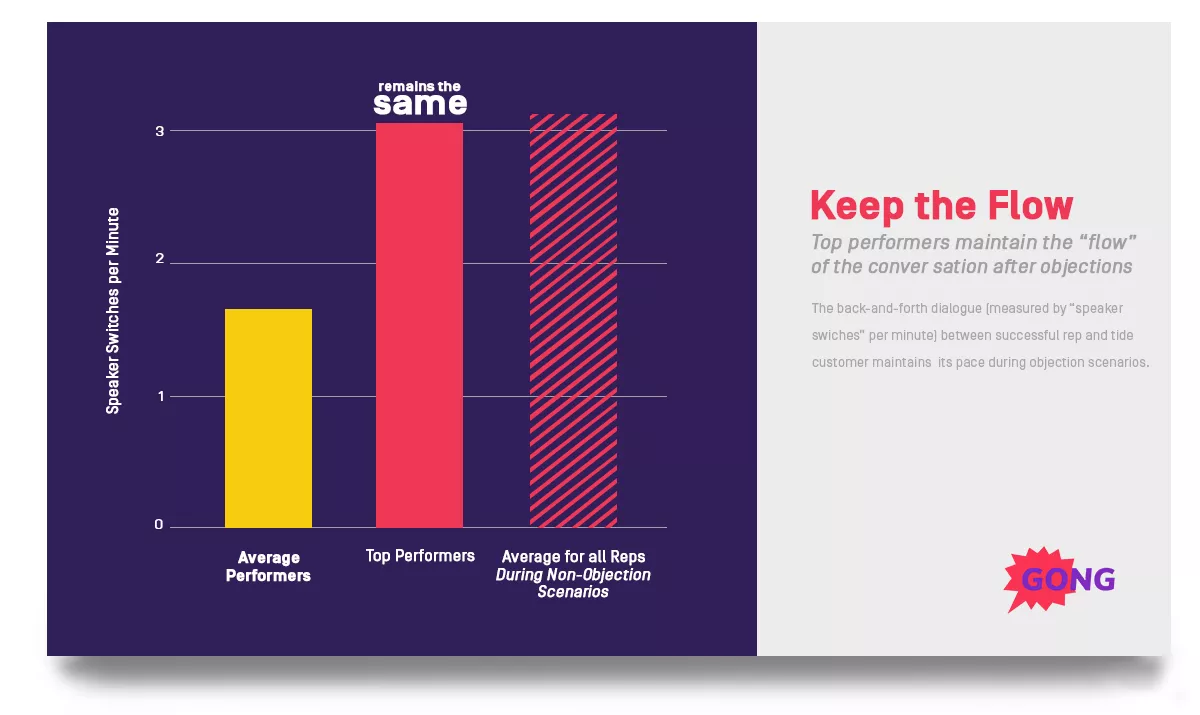
Handling a sales objection successfully, then, may simply come down to handling a sales objection strategically.
So don’t rush into your response. Be sure that you’re answering your lead’s questions in a way that gets to the heart of their objection.
And never be dismissive of that objection either—a problem you can avoid by practicing active listening.
2. Practice Active Listening
In order to serve your customers, you have to understand their needs, right?
Well, the same rule applies when selling leads on your product or service.
The more you understand their problems and their objections to buying today, the more likely you’ll be to turn them into your customer.
That’s where active listening comes in.
Active listening is basically a set of skills you or your sales team can use to…
- Better understand your customers’ objections.
- Let your customers know that you understand where they’re coming from.
These skills include being attentive, summarizing what they’ve told you, and asking probing questions (more on that later).
Plus, more active listening is actually associated with a higher close rate among salespeople.
For instance, Sales Hacker found that the bottom 20% of salespeople spent over 65% of conversations pitching their products.
But the top closers spent just over 40% pitching—the rest was spent listening to the customer.
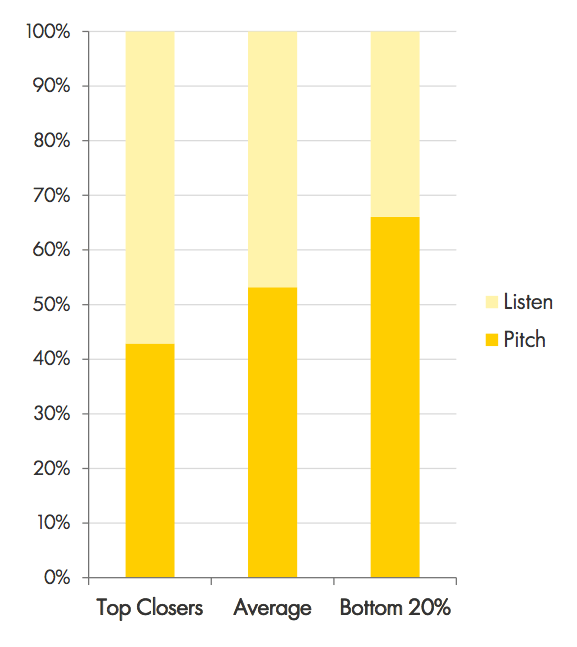
While a lot of salespeople are more comfortable with taking the reigns and controlling the conversation by talking more, the data seems to show something different,
Listeners are actually more successful in handling objections in sales and closing.
3. Avoid Monologuing & Keep the Flow Going
When met with an objection, a lot of salespeople go into long, drawn-out explanations of how their product addresses that sales objection.
Gong (again) analyzed the flow of sales calls and called these long explanations “knee-jerk monologues”.
At first, conversation flows smoothly, passing from the salesperson to the lead and back again.
But once an objection is mentioned, a salesperson will typically jump into defensive mode and overreact to that objection.
The flow of the conversation looks like this.

Now, the interesting takeaway here is that high-performing salespeople actually spent less time monologuing after an objection was raised.
In fact, their answer to the objection is about half as short as average performers.

Beyond that, top performers kept the flow of the conversation the same as it was before the objection was raised.
Sales calls with average performers, on the other hand, included much less speaker switches per minute (meaning the customer had fewer chances to speak).

So if you want to address lead objections successfully and close more sales, the trick is to keep the flow of the conversation the same, even when faced with an objection.
4. Respond to Leads Quickly
When it comes to closing sales, the early bird definitely gets the worm.
According to a study from Lead Response Management, salespeople who respond to inquiries in under 5 minutes are 100X more likely to connect with prospects and 21X more likely to qualify them.

Part of this is due to the fact that when prospects reach out to companies, they are in the learning mindset.
They want to learn more about your company. They want to hear why you’re superior to your competitors. They want your product or service to be the solution they’ve been looking for.
But the longer you wait to reach back out to them, the lower their enthusiasm will be.
They’ll think of reasons why you’re not actually a good fit.
They’ll research your competitors and get a better idea of differences in pricing and features.
They’ll essentially have more ammunition for firing objections at you when you do get on the phone.
So if you want to prevent a barrage of objections, try contacting leads faster (a huge benefit of incorporating chatbots into your sales process).
You may also want to create an email autoresponder and add that to your high-ticket sales funnel as well.
5. Be Persistent With Your Contacting
Most contacts won’t be ready to talk (let alone buy) right off the bat.
Instead, clinching the sale takes a lot of persistent follow-up on your part.
When it comes to increasing your contact rates, 6 is the magic number.
Research conducted by Velocify found that making at least 6 attempts to contact a lead dramatically increased contact rates.

This plays on one of the 11 Laws of Sales Funnel Physics, “ The Law of Repetition”.
Basically, by hearing from or hearing about the same brand or person more and more over a period of time, a prospect is more likely to engage by picking up the phone or even buying a product outright.
That being said, the law of diminishing returns does also play a role here.
As you go past more than 6 attempts to get in touch, the increase in probability of making contact drops further and further.
As a result, it may be in your best interest to simply know when to quit to maximize the value of your time (one of many vital tips for salespeople).
6. Ask Plenty of Questions
Your prospects don’t just want to hear a sales pitch about your high-ticket product or service.
If that was all they wanted, they’d be able to make a decision right from your website.
Instead, most leads for high-ticket products or services will want to get on the phone so they can see your solution is right for their unique problem.
And the more questions you ask to learn about their problem, the better the odds will be of closing the sale.
For example, the team over at Sales Hacker (which actually partners with Gong.io from earlier) found that as sales reps asked more questions, their success rate actually rose too.

As you can see, the success rate actually rose with the number of questions being asked on the call.
That’s because customers want to be treated like people, not just sales numbers.
Salesforce actually found that this is important to the overwhelming majority of customers—84% in fact.
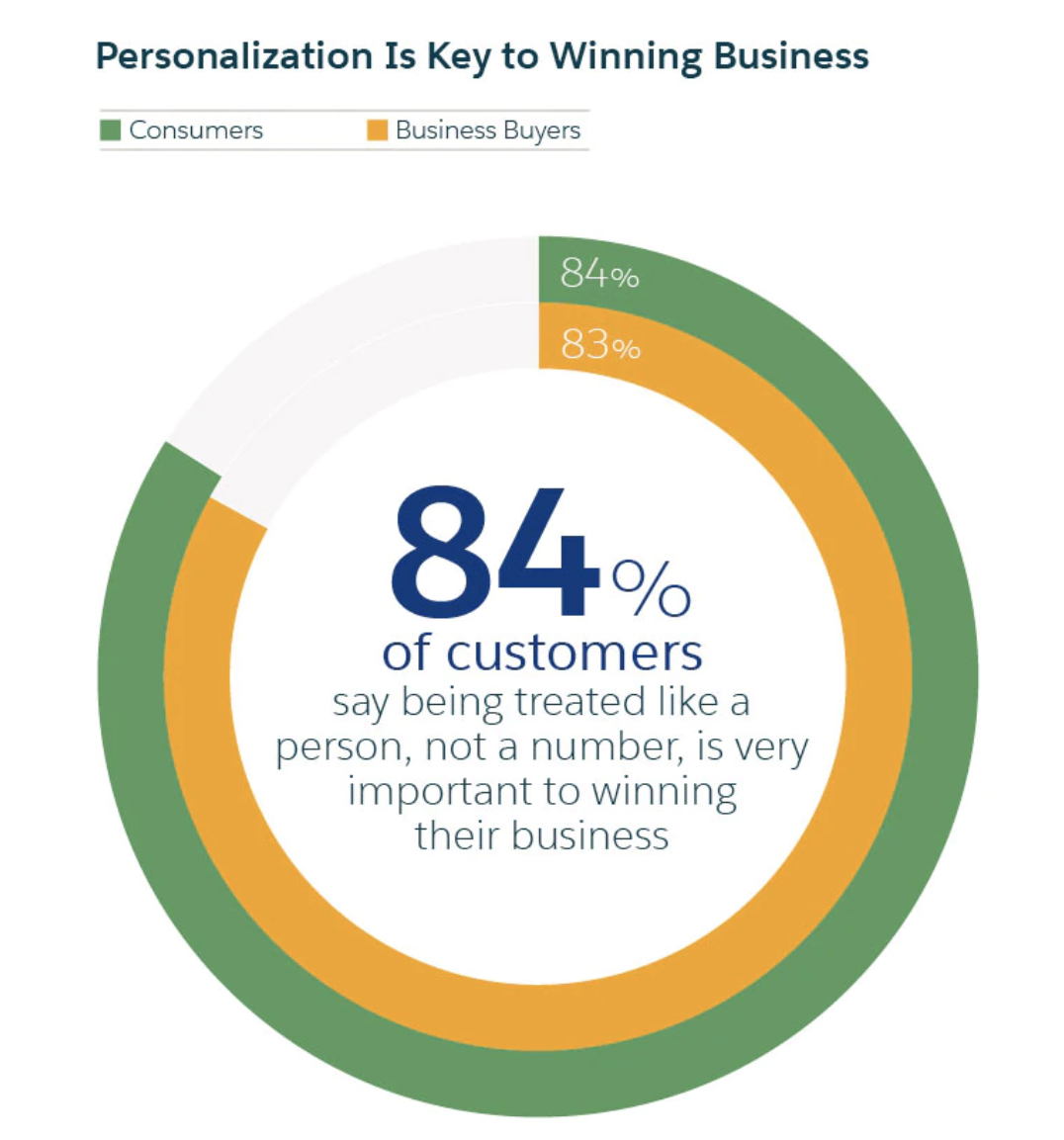
On top of that, SuperOffice found that customers feeling a company does not care about them was one of the top reasons they left and found another provider.
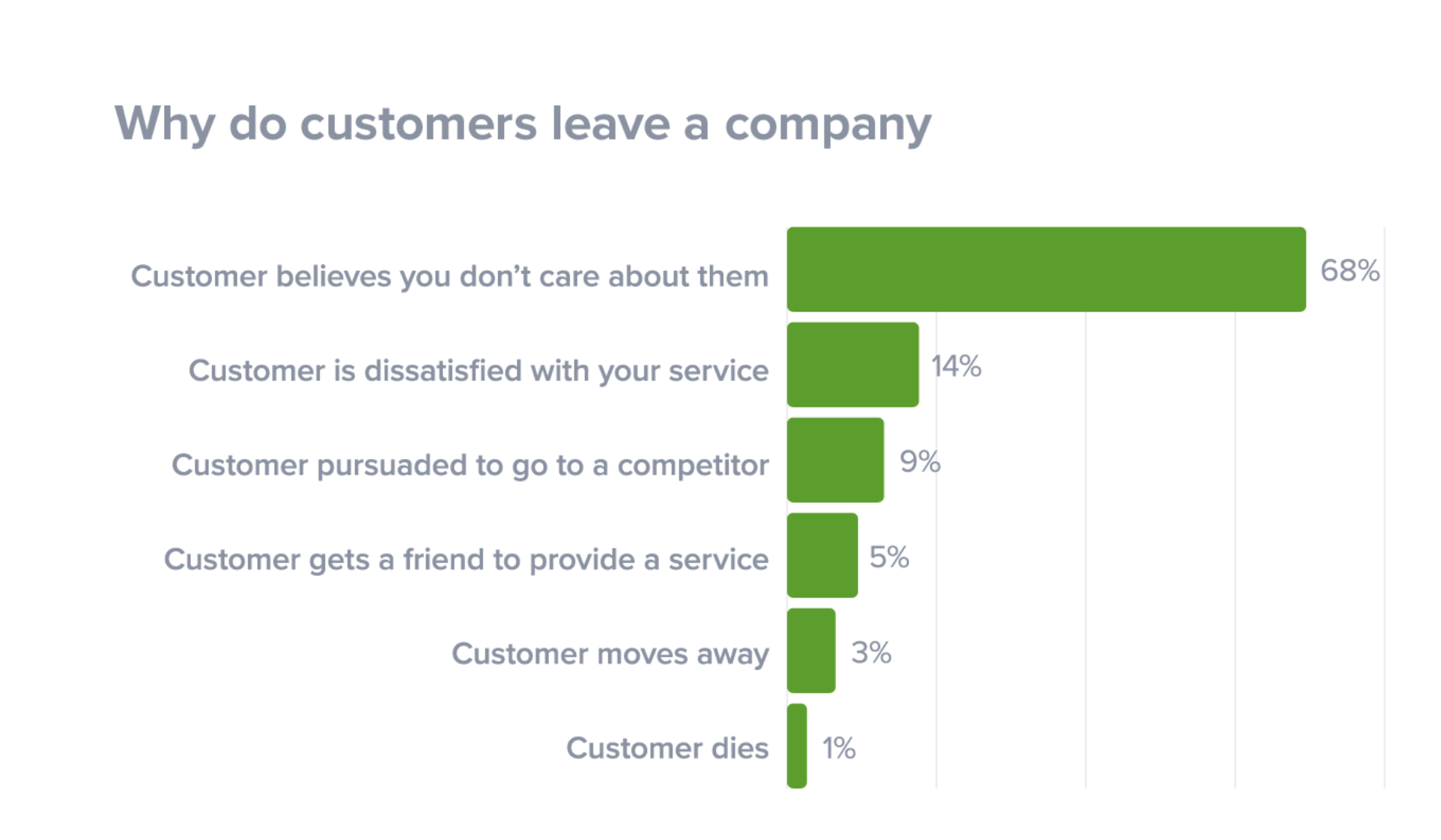
But beyond all of that, another reason you should be asking more questions is because these questions can be especially helpful in qualifying leads.
Lead qualification is an incredibly important step for high-ticket sales. And you should be taking extra steps to qualify your leads before you get on the phone.
But once you have made contact, it’s still your job to figure out if a lead is actually a good fit for your product or service.
Asking lots of questions during the sales call can help you determine if, in fact, you do have the solution to the prospect’s problem.
7. ...But Don’t Ask TOO Many Questions
Now, questions are great. And they’re super important for addressing sales objections.
But all that being said, you don’t want to ask too many questions either.
Sales Hacker actually found that after 11-14 targeted questions per call, the success rate of the sale will actually drop.
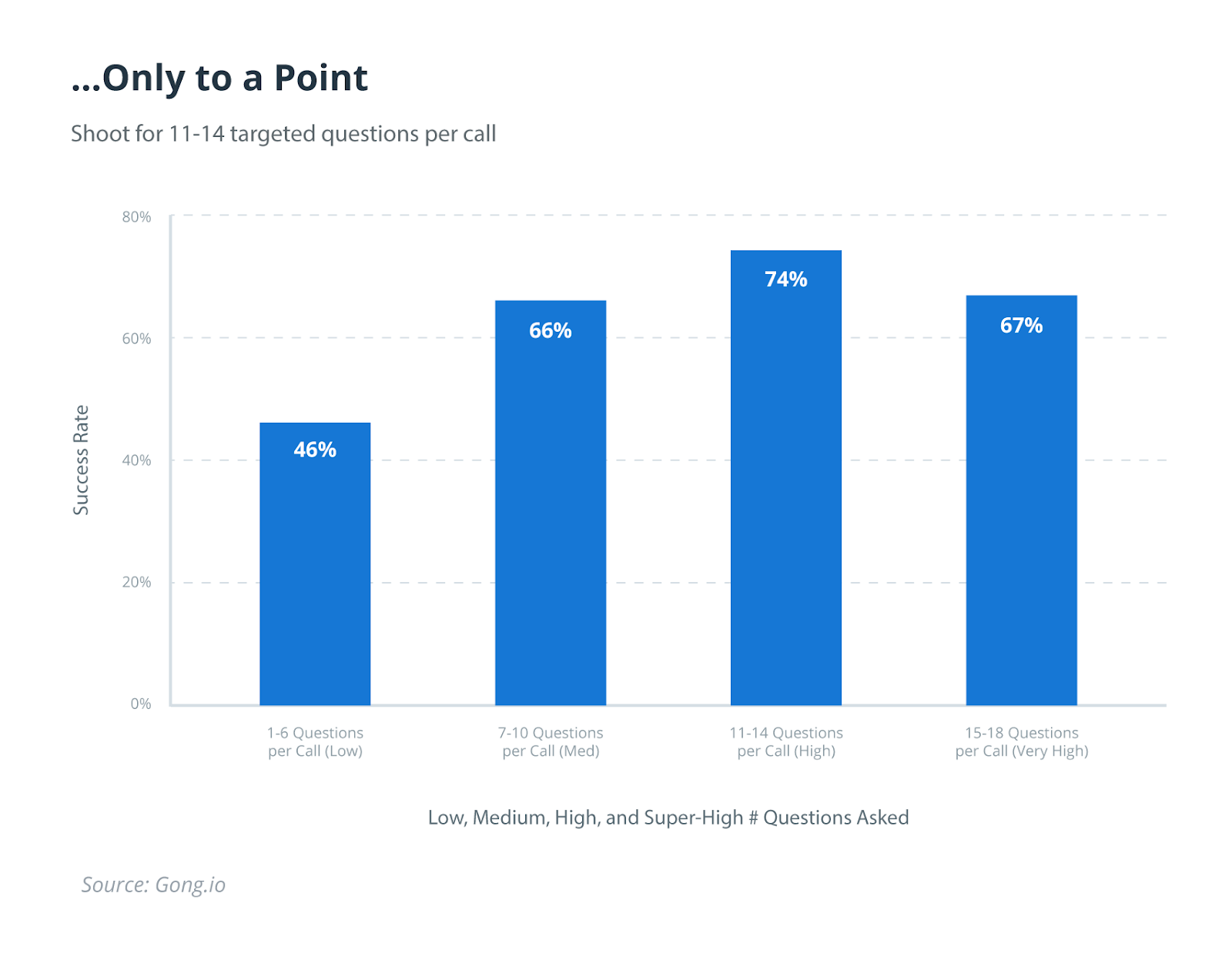
The reason for this isn’t super clear.
Perhaps it’s annoyance from the prospect for being too much of the focus of the call.
Maybe it’s that when questions get out of hand it seems like the sales team doesn’t know anything about the lead.
Whatever the reason is, the data seems to show that there is a sweet spot for just how inquisitive your salespeople should be.
Techniques for Addressing 5 Specific Sales Objections
Now that you know how to approach addressing sales objections, let’s take a deeper dive into more specific types of objections.
You’re going to run into a lot of different types of objections in your business. But in general, they’ll usually fall into 1 or more of 5 different categories:
- Your Product/Service Is Too Expensive
- Now Is Not the Right Time for Me to Buy
- I Need to Check With Other Stakeholders
- I Don’t Think This Will Work for Us
- We Are Going to Go With X Competitor Instead
Each category of sales objections is important to address in your sales pitch. And each can be solved by the tactics below.
Sales Objection #1: Your Product/Service Is Too Expensive
Price is a big one.
In a survey from HubSpot, more than 1 out of 3 sales reps finds addressing customers’ price objections to be challenging.
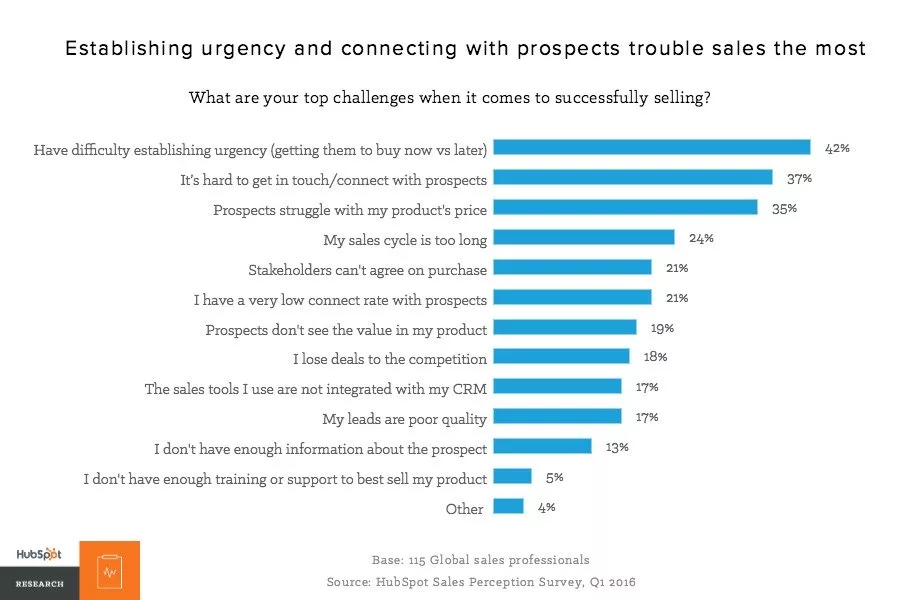
And it makes sense!
Price is an important topic, especially when you’re dealing with high-ticket items and/or you’re a B2B business.
So, how do you address the all-too-common pricing objection?
- Technique #1: Circle Back to Product Value – Keeping the focus on price alone is dangerous because if that’s the only thing under the lens, there’s no way of competing with cheaper alternatives. Instead, focus on the value your product or service provides.
- Technique #2: Revisit ROI, Features, & Benefits – Instead using price alone, hit the features and benefits again, this time with a particular focus on ROI. Mention case studies and past success stories to strengthen the point that your solution works.
- Technique #3: Set Up a Contrast – Frame the value of your product or service in terms of what will happen if they don’t solve the problem your solution addresses. If you can communicate that a small investment now will lead to big payoff later, it can stop this sales objection dead in its tracks.
Sales Objection #2: Now Is Not the Right Time for Me to Buy
The problem with this objection is that many of these buyers actually are ready to buy.
The only thing holding them back is the initial commitment of spending resources. And in all likelihood, their situation won’t be any different 2, 3, or even 6 months from now.
As a salesperson, then, it’s your job to persuade them that now is the right time to make the purchase.
And in fact, this is often the biggest challenge when it comes to successfully selling.
Heading back to HubSpot’s survey of global sales teams mentioned in the last point, they found that a massive 42% of sales professionals rated this as the top challenge.

Here’s how to address this type of sales objection:
- Technique #1: Get Them Talking – Many times, this objection is covering up a deeper problem (budget running out, other priorities on the table, already being sold to from competitors, etc.). This can open up the door to new problems at the root that you can solve individually.
- Technique #2: Give Them a Deal – If time is the problem, make it sweeter for them to commit right now by offering a discount, trial period, or a free service. Sometimes a little bit of incentive is all it takes to push the needle with a prospect.
- Technique #3: Bring Out the Big Guns – If all else fails, ask your CEO or sales leader to reach out (depending on the size of your company). By connecting prospects with higher-ups in the company, you’re showing that you really do care about their business. And that might get them on the phone long enough to close the deal.
Sales Objection #3: I Need to Check With Other Stakeholders
This one is a bit tricky because you should have gotten all the decision makers on the phone in the first place.
Doing so is actually 1 of the 11 “god-mode” strategies that can help you close 481% more high-ticket sales.
But even still, if you do come across this objection, there are a few ways you can address it.
- Technique #1: Set Up a Meeting With Stakeholders – Be extra careful of letting prospects sell your solution to others in their company. Because in all likelihood, they won’t be able to do it. But you can. Ask to set up a new meeting with all the major players so you can give them your best pitch, not a watered down version.
- Technique #2: Give Them Everything They Need to Be Successful – If you can’t set up a new meeting, make sure to provide the prospect with everything they need to present your solution in the best light. Powerpoint presentations? ROI figures? Entire pitch decks? Do whatever it takes to give them the best odds of success.
Sales Objection #4: I Don’t Think This Will Work for Us
This sales objection either comes from a place of misunderstanding or (hopefully not) a genuine incompatibility with your solution.
To determine which you’ve encountered, the first step is to ask more questions.
Heading back to the Gong study from earlier, an analysis of 67,149 sales calls found that top performers followed up 54.3% of objections with a clarifying question. For average performers, it was just 31%.

So, how do you address this objection once you’ve determined that your solution is in fact right for your prospect?
- Technique #1: Walk Through the Buying Process – Sometimes hesitation can come from a point of being worried about the next steps. Let them know how it will all play out step-by-step after they become a customer. This can help make them feel more at ease about the entire experience.
- Technique #2: Use That Social Proof – Social proof is a salesperson’s most valuable tool for addressing sales objections. Case studies, testimonials, vanity stats, and more are all great here. But pay extra special attention to case studies of buyers that were facing the same problem as your current prospect. This will help show that, yes, this product is in fact perfect for them. It’s why we have such a diverse range of industries on our own Our Work page. See?


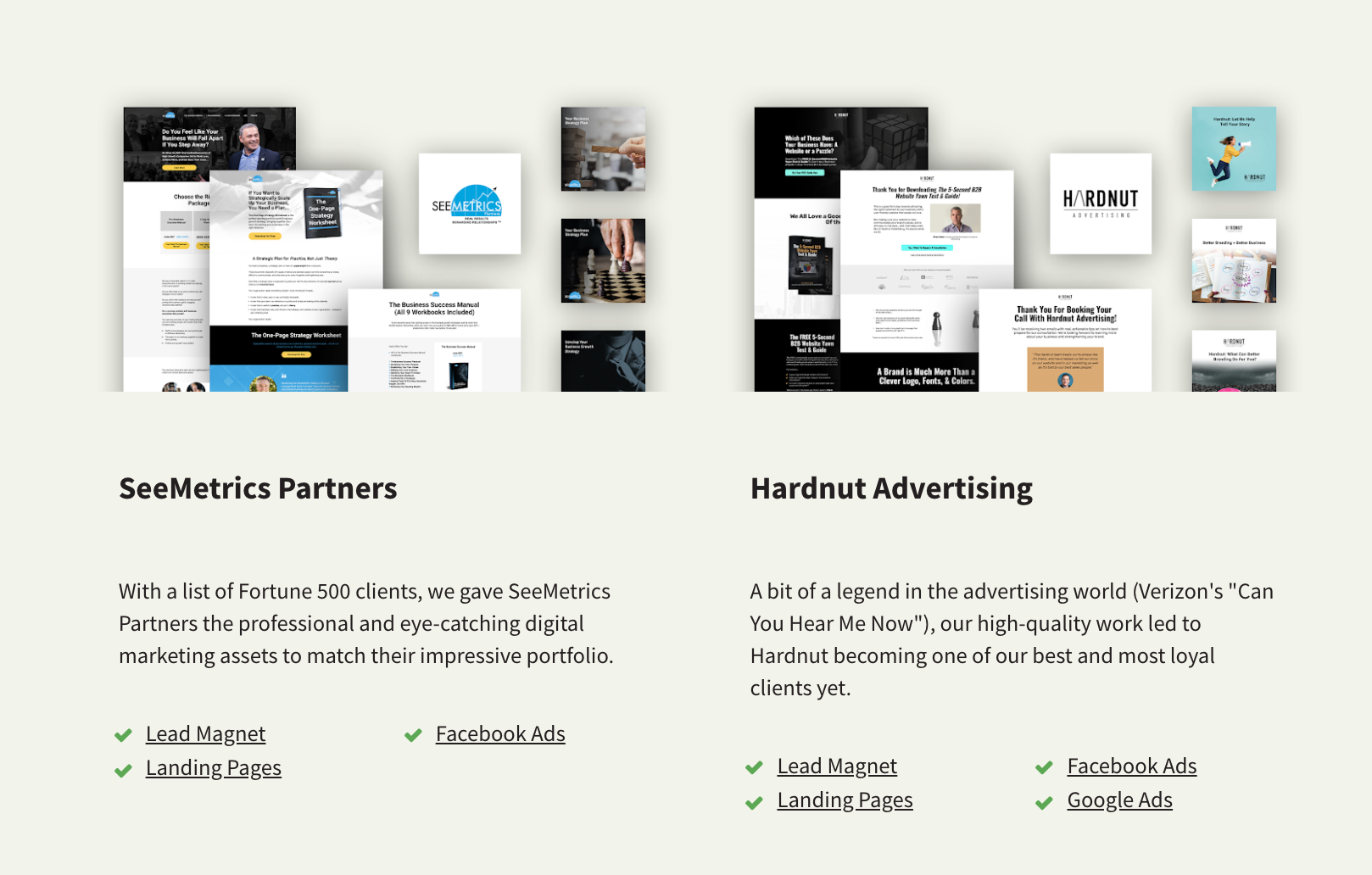
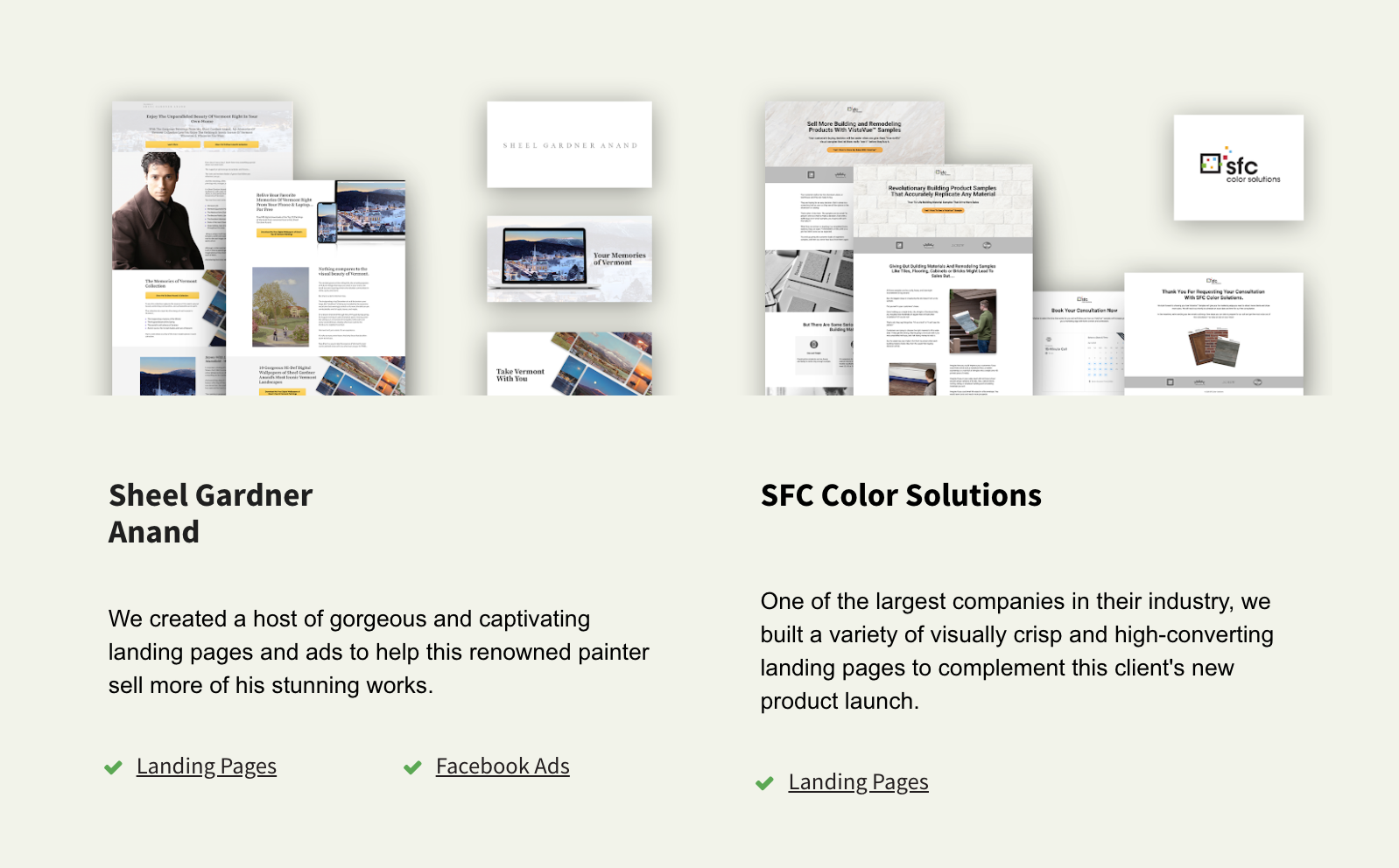
Sales Objection #5: We Are Going to Go With X Competitor Instead
This is a tough one. If a prospect is already working with another company that’s offering a similar solution, you may be tempted to simply call the whole thing quits.
But question: why are they even talking to you in the first place?
No matter how long a business partnership has been, there are always going to be sore points in the relationship.
And if you want to overcome this sales objection, it’s your job to find out what those sore points are.
Now, be sure to be tactful about this point.
Bad mouthing the competition is definitely frowned upon by prospects. And there are few better ways to tear down your business’ reputation in their eyes than knock down another company.
Even still, here are a few ways to get around this sales objection:
- Technique #1: The Direct Comparison – First, you can call out the differences between your business and the competition. Tell them about the unique goals that other companies have accomplished when they switched from your competition over to you. And be sure to tell them why they were able to accomplish those goals by highlighting your product/service’s features.
- Technique #2: The “Just Want to Show You Around” Approach – Tell your prospect that there’s absolutely no pressure to buy right now. You just want to give them a quick walkthrough of how your product or service is different from the company they are using now. And if you have case studies of businesses that have chosen you over the competition, then be sure to point those out.
Conclusion
Addressing sales objections can be daunting at first.
If you don’t have all the answers right off the bat, you may feel like that sale is going to slip away forever.
But if you go into a sales meeting with the right techniques and strategies for handling objections in sales, you can start closing more high-ticket sales and (best of all) turn selling into something you actually look forward to.
Actually, becoming a better salesperson is just one of the points I cover in the 6-Figure Sales Funnel Training.

This training includes everything you need to build a better sales funnel and learn how to persuade prospects that your product or service is the solution to their problems.
Check it out.
Now, what are some other sales objections you or your team have encountered? What other techniques or strategies have you used to solve them? And what have the results been?
Let me know in the comments below.
Keep AutoGrowin’, stay focused.


